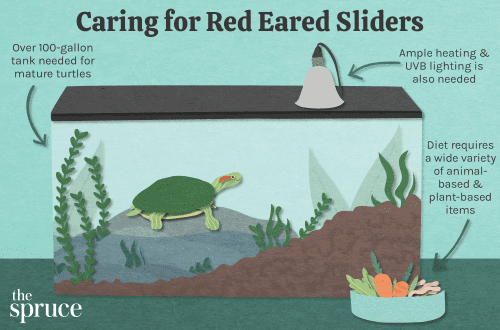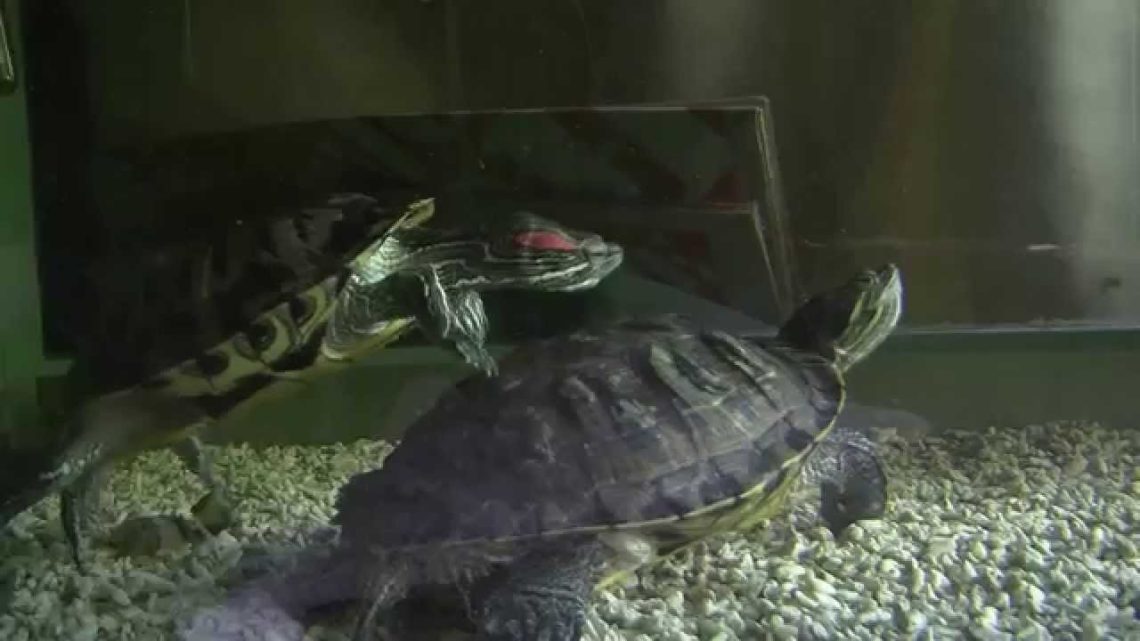
Reproduction of red-eared turtles: mating and breeding at home (video)
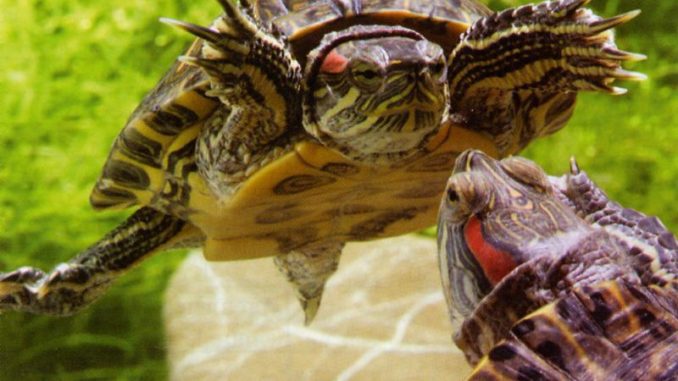
In nature, numerous viable offspring are born in aquatic turtles in one season, but in captivity, freedom-loving reptiles breed quite reluctantly. Reproduction of red-eared turtles at home is a rather troublesome, but very exciting activity that requires studying the physiology of unusual animals and creating optimal conditions. But all the troubles are forgotten at the time of the birth of young cute turtles, watching which is a real pleasure for all family members.
Contents
At what age do they breed
Under natural conditions, aquatic turtles reproduce only when they reach puberty, which occurs only at 6-8 years of age. The puberty of redworts, kept in comfortable home conditions, falls on 3-4 years for males and 5-6 years for females. Herpetologists recommend selecting 5-year-old healthy individuals with pronounced species characteristics for mating.
It is almost impossible to know the exact age of a freshwater reptile; animals are brought from Europe without birth data. The growth rate, shell formation, the presence of annual rings, and the characteristic change in scutes directly depend on the conditions in which exotic animals are kept. Therefore, the age of puberty in red-eared turtles is very conditionally determined by the length of the shell. Males at the age of 5 have a shell length of about 11 cm, and females – at least 15-17 cm.
The difference between a male and a female
Aquatic turtles do not have external sexual characteristics, so for beginners there are certain difficulties in determining the sex of pets. To establish the gender of reptiles, it is recommended to conduct a simultaneous comparison on the following grounds:
After determining the sex of pets, you can start breeding red-eared turtles. To obtain turtle offspring, it is necessary to have at least one heterosexual pair of reptiles at home, or better, several girls and one or two boys.
How to prepare for mating
Most often, it is not possible to breed red-eared turtles at home due to the lack of optimal conditions for the reproduction of reptiles. For successful offspring, it is recommended to create a comfortable atmosphere for pets:
- transfer to enhanced nutrition with the addition of calcium-containing foods, vitamins and fresh herbs;
- raise the temperature in the aquarium to 25-26C;
- increase daylight hours with lighting lamps;
- exclude all extraneous noises, sounds, close attention.
It is best to send heterosexual red-eared turtles in November for wintering – a long hibernation, due to which the hormonal background in males and females is normalized and synchronized.
Mating season and mating
At home, freshwater reptiles can mate year-round, but most often red-eared turtles mate in the spring from March to May. One successful sexual intercourse of a female is enough for 4-5 laying of turtle eggs. Several options for dating heterosexual individuals are allowed. If boys and girls are kept separately, then for mating one female is planted on the territory of the male. With group keeping, it is necessary to carefully monitor the behavior of reptiles; if interest arises, a love couple must be planted in a separate aquarium.
Before mating, the male red-eared tortoise looks after the female he likes very nicely. The boy swims in front of his “lady” with his tail forward, and his long claws vibrate when he touches the muzzle of his beloved. The mating season in red-eared turtles is manifested by the contact of shells in water and on land, as well as bloody fights of males for the right to love the girl they like.
Video: courtship of a male red-eared turtle for a female
Red-eared turtles mate in the water, sexual intercourse takes about 5-11 minutes, during intercourse, the boy tightly hugs his girl from behind with long claws of the forelimbs. During mating and mating, the male may not release the female onto land, so the water level in the aquarium should be no more than 10-12 cm, otherwise the female may choke and die. In the room where the aquarium with a love couple is installed, it should be quiet and calm. Stress and loud noises can disrupt the mating process, so you should not make noise and pull the animals out of the aquarium. The water temperature must be at least 26C.
Video: mating
How long does pregnancy last?
After successful fertilization, the pregnancy of the red-eared turtles occurs, which lasts about 60 days. When the male is kept together, it is better to set aside this period in order to avoid harm to the health of the mother and future turtles. The female is transferred to enhanced nutrition. The reptile must receive calcium, phosphorus and vitamins. Toward the end of pregnancy, the female will sort out food or refuse to eat at all, which should not be a reason for panic.
In their natural habitat, freshwater reptiles come to land to lay their eggs in the warm sand. A pregnant turtle kept at home is recommended to install a deep container filled with sand by 10-15 cm on the shore of the aquarium. The animal can lay eggs in the water, but if the owner does not get them within an hour, the embryos will die from lack of air.
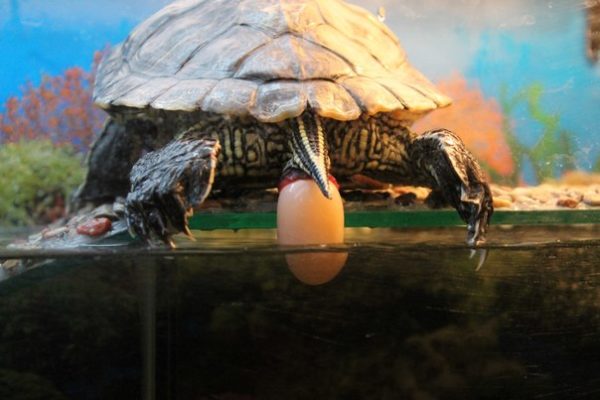
Immediately before laying, the pregnant turtle begins to dig a nest with its hind limbs, forming a deep hole with a perfectly even entrance. Egg laying lasts 5-20 minutes, the female corrects each egg with her hind legs. Eggs of red-eared turtles are like balls with a diameter of 3-4 cm with a soft leathery shell; in one laying, the animal can carry about 5-20 eggs. Having laid eggs, the reptile carefully buries the nest, moistens it with urine and forgets about its cubs forever. Further care for the babies falls on the shoulders of the future owners of the turtles.
How to care for eggs
Before you breed red-eared turtles, you need to take care of purchasing an incubator for the maturation of small turtles. Although reptile lovers successfully grow babies in an ordinary glass jar of sand, provided that the optimum temperature and humidity are maintained. Even females, which are kept without males, can lay eggs, but they do not have turtle embryos inside.
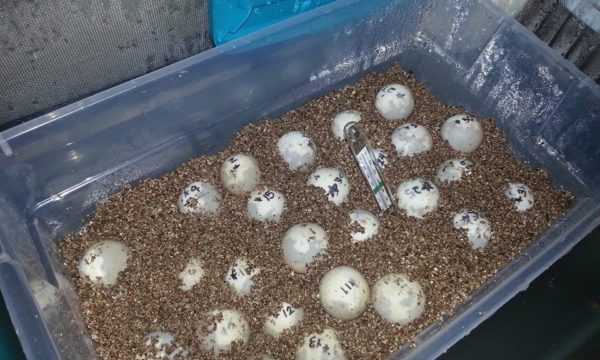
If a pet reptile laid eggs in the sand, they must be carefully moved to the incubator without changing their original position. If the laying was done in water, the eggs must be removed within an hour, but they have a lower chance of survival. Before laying eggs in the incubator, they must be illuminated with an ovoscope, flashlight or light bulb for the presence of embryos.
Egg incubation is from 2 to 5 months, but most often the babies hatch after 103 days. The temperature in the incubator should be maintained at 28-30C, the sand should be sprinkled with water periodically. If bugs are wound up in the soil, it is necessary to carefully change the filler without changing the original position of the eggs.
Caring for newborn baby turtles
Babies pierce the shell from the inside with a special egg tooth, but remain in the shell for another 3 days. Do not rush the process and independently extract newborns from eggs. Baby red-eared turtles are born with a yolk sac on their abdomen, which resolves on its own within a few days. Turtles are born as small copies of adults, and from the first days they are already ready for independent life. It is highly recommended not to send the cubs to the aquarium with their parents, turtles do not care about their offspring and can kill their own babies.
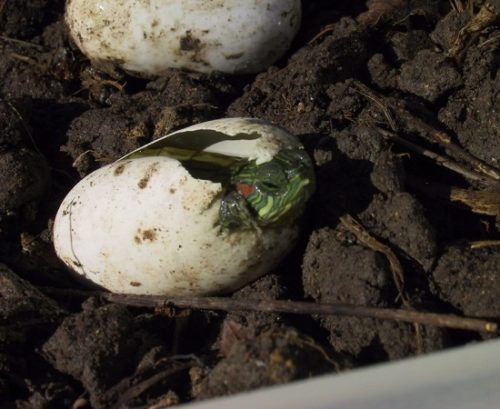
Newborns are still kept in the incubator for 5 days, and then they are placed in their own aquarium with settled clean water at 28-30C. Toddlers still do not know how to swim, so the water level must be increased gradually and the first days to control the behavior of turtles in new conditions. A prerequisite for proper growth of the young is a water filtration system and a 5% UVB reptile lamp.
Closer to the 7-8th day from birth, you can accustom kids to an adult diet. Turtles are given animal food: daphnia, gammarus, bloodworm, coretra, fresh herbs, pieces of sea fish, shrimp. Vitamin and mineral complexes for reptiles are added to the natural diet, which are necessary for the proper growth of the skeleton, shell and development of vital organ systems.
Breeding of red-eared turtles brings pleasure only to very patient owners, and baby turtles of toy sizes from the first days of life become everyone’s favorites.
How do aquatic red-eared turtles breed and mate?
3 (60%) 74 votes




